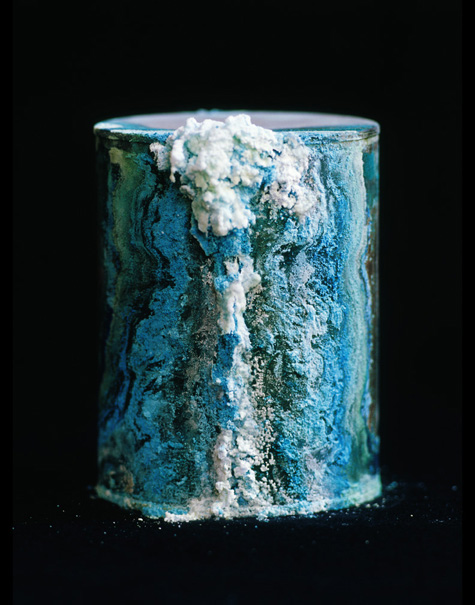 [Image: From Library of Dust by David Maisel, published by Chronicle Books].
[Image: From Library of Dust by David Maisel, published by Chronicle Books].
There’s a spectacular new book coming out at the end of this summer called Library of Dust, by photographer David Maisel, published by Chronicle Books. I had the intensely exciting – and flattering – opportunity to write one of the book’s introductory essays; that essay now re-appears below.
I first learned about Library of Dust when I interviewed Maisel back in 2006 for Archinect. In 1913, Maisel explained, an Oregon state psychiatric institution began to cremate the remains of its unclaimed patients. Their ashes were then stored inside individual copper canisters and moved into a small room, where they were stacked onto pine shelves.
After doing some research into the story, Maisel got in touch with the hospital administrators – the same hospital, it turns out, where they once filmed One Flew Over the Cuckoo’s Nest – and he was granted access to the room in which the canisters were stored.
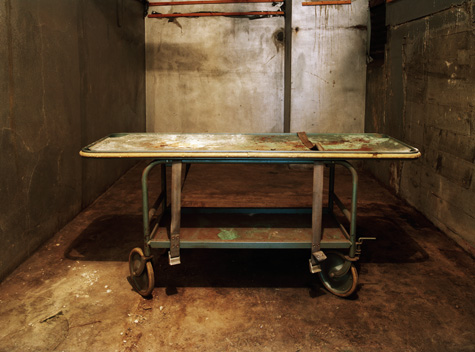
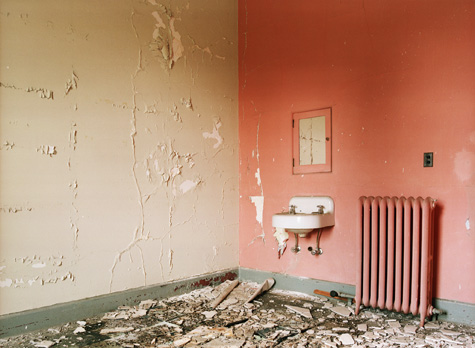
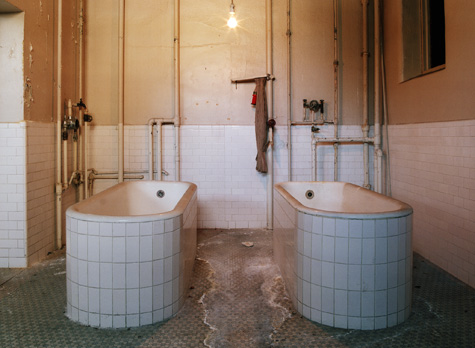 [Image: Abandoned rooms of the hospital. From Library of Dust by David Maisel, published by Chronicle Books].
[Image: Abandoned rooms of the hospital. From Library of Dust by David Maisel, published by Chronicle Books].
Over time, however, the canisters have begun to react chemically with the human ashes held inside them; this has thus created mold-like mineral outgrowths on the exterior surfaces of these otherwise gleaming cylinders.
There was a certain urgency to the project, then, as “the span of time that these canisters are going to be in this state is really finite,” Maisel explained in the Archinect interview, “and the hospital is concerned that they’re now basically corroding.”
So when I was there just a few weeks ago, photographing for I think the fourth time, there was a proposal being floated that each canister be put into its own individual plastic bag, and then each bag would go into its own individual black box that’s made for containing human ashes. And that would be it.
To me, the arc of the project – if it ends like that, which it seems it probably will – has a certain kind of conceptual logic to it that I appreciate. I appreciate the form and the story of these canisters, that they’re literally breaking down further every day, even between my visits to the hospital. My time of doing it, then, is finite as well.
In order to deal with the fragility of the objects, and to respect their funerary origins, Maisel set up a temporary photography studio inside the hospital itself. There, he began photographing the canisters one by one.
He soon realized that they looked almost earthlike, terrestrial: green and blue coastal forms and island landscapes outlined against a black background. But it was all mineralogy: terrains of rare elements self-reacting in the dark.
Maisel’s photos have now been collected into a gorgeous, and physically gigantic, book. It’s expensive, but well worth checking out.
The following is my own essay for the book; it appears alongside texts by Terry Toedtemeier and Michael Roth.
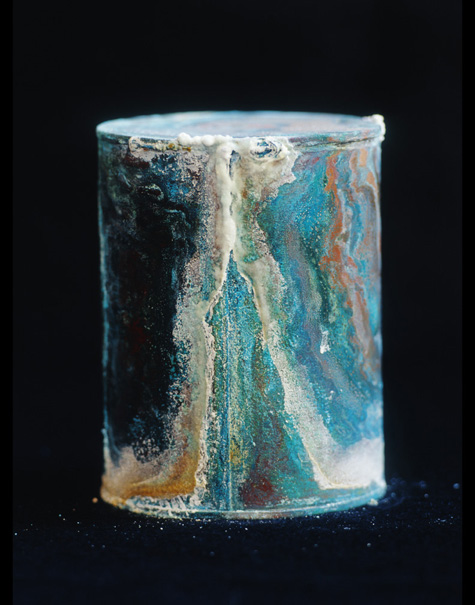 [Image: From Library of Dust by David Maisel, published by Chronicle Books].
[Image: From Library of Dust by David Maisel, published by Chronicle Books].
In Haruki Murakami’s novel Hard-boiled Wonderland and the End of the World, an unnamed man finds himself walking through an unnamed town. Its depopulated spaces are framed most prominently by a Clocktower, a Gate, and an Old Bridge. The nameless man is told almost immediately to visit the town’s central Library – an unspectacular building that “might be a grain warehouse” for all its allure. “What is one meant to feel here?” the man asks himself, crossing a great, empty Plaza. “All is adrift in a vague sense of loss.”
Once inside the Library, the man meets a Librarian. The two of them sit down together, and the man prepares to read dreams. They are not fairy tales written in pen and ink, however, but the psychic residues of long-dead creatures, a gossamer field of electrical energy left behind in the creatures’ bleached skulls. Weathered almost beyond recognition, one such skull is “dry and brittle, as if it had lain in the sun for years.” The skull has been transformed by time into something utterly unlike itself, marked by processes its former inhabitant could not possibly have anticipated.
Each skull is the most minimal of structures, seemingly incapable of bearing the emotions it stores hidden within. One skull in particular “is unnaturally light,” we read, “with almost no material presence. Nor does it offer any image of the species that had breathed within. It is stripped of flesh, warmth, memory.” It is at once organic and mineralogical – living and dead.
The skull is also silent, but this silence “does not reside on the surface, [it] is held like smoke within. It is unfathomable, eternal” – intangible. One might also add invisible. This “smoke” is the imprint of whatever creature once thought and dreamed inside the skull; the skull is an urn, or canister, a portable tomb for the life it once gave shape to.
The Librarian assists our nameless narrator by wiping off a thin layer of dust, and the man’s dream-reading soon begins.

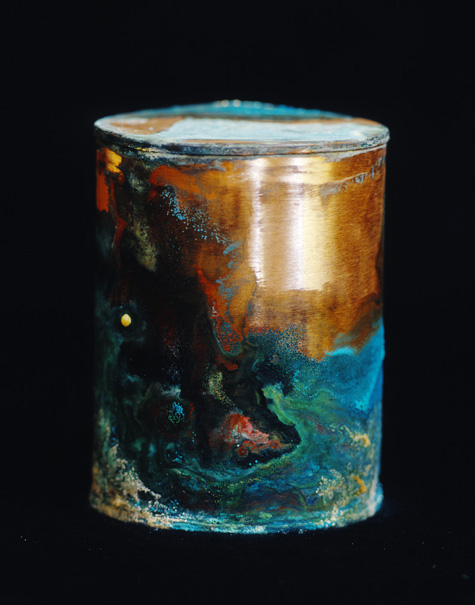
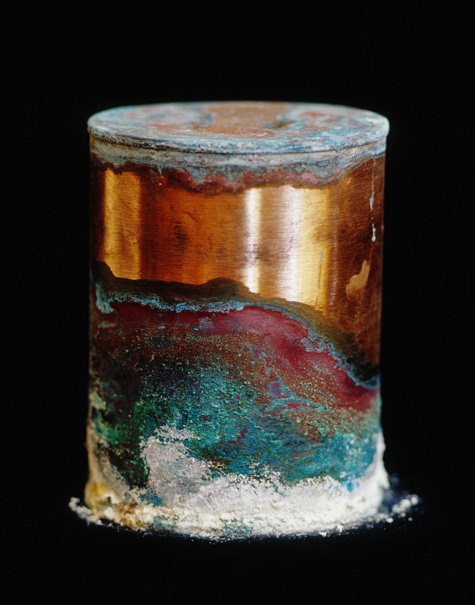
[Images: From Library of Dust by David Maisel, published by Chronicle Books].
Dust is a peculiar substance. Less a material in its own right, with its own characteristics or color, dust is a condition. It is the “result of the divisibility of matter,” Joseph Amato writes in his book Dust: A History of the Small and the Invisible. Dust is a potpourri of ingredients, varied to the point of indefinability. Dust includes “dead insect parts, flakes of human skin, shreds of fabric, and other unpleasing materials,” Amato writes.
Many humans are allergic to dust and spend vast amounts of time and money attempting to rid their homes and possessions of it, yet dust’s everyday conquest of the world’s surfaces never ends. Undefended, a room can quickly be buried in it.
Dust lies, of course, at the very edge of human visibility: it is as small as the unaided eye can see. And dust is not necessarily terrestrial. “Amorphous,” Amato continues, “dust is found within all things, solid, liquid, or vaporous. With the atmosphere, it forms the envelope that mediates the earth’s interaction with the universe.” But dust is found beyond that earthly sphere, in the abiotic vacuum of interstellar space, a freezing void of irradiated particles, where all dust is the ghostly residue of unspooled stars, astronomical structures reduced to mist.
Strangely representational, the chemistry of this stardust can be analyzed for even the vaguest traces of unknown components; these results, in turn, are a gauge for whatever hells of radiation once glowed, when the universe burned with intensities beyond imagining. Those astral pressures left chemical marks, marks which can be found on dust.
Such dust – vague, unspectacular, bleached and weathered by a billion years of drifting – can be read for its astronomical histories.
Dust, in this way, is a library.
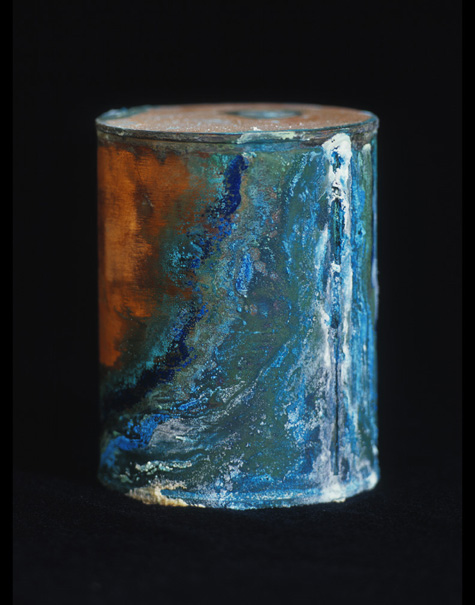 [Image: From Library of Dust by David Maisel, published by Chronicle Books].
[Image: From Library of Dust by David Maisel, published by Chronicle Books].
A geological history of photography remains unwritten. There are, of course, entire libraries full of books about chemistry and its relationship to the photographic process, but what the word chemistry fails to make clear is that these photographic chemicals have a geological origin: they are formed by, in, and because of the earth’s surface.
Resists, stops, acids, metals, fixes – silver-coated copper plates, say, scorched by controlled exposures of light – produce imagery. This is then called photography. Importantly, such deliberate metallurgical burns do not have to represent anything. Photography in its purest, most geological sense is an abstract process, a chemical weathering that potentially never ends. All metal surfaces transformed by the world, in other words, have a literally photographic quality to them. Those transformations may not be controlled, contained, or domesticated, but the result is one and the same.
Photography, in this view, is a base condition of matter.
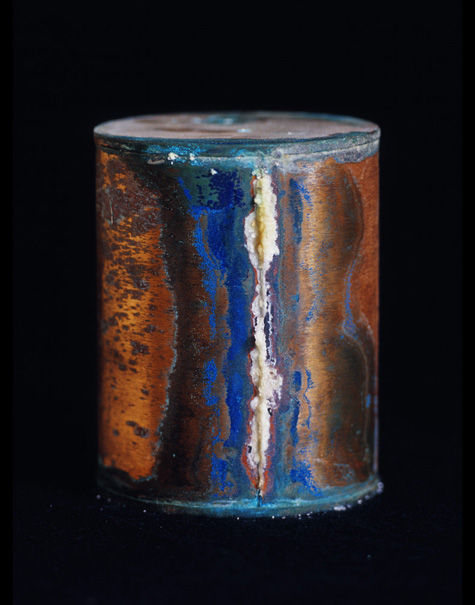 [Image: From Library of Dust by David Maisel, published by Chronicle Books].
[Image: From Library of Dust by David Maisel, published by Chronicle Books].
David Maisel’s photographs of nearly 110 funereal copper canisters are a mineralogical delight. Bearded with a frost of subsidiary elements, their surfaces are now layered, phosphorescent, transformed. Unsettled archipelagos of mineral growths bloom like tumors from the sides and bottoms – but is that metal one sees, or some species of fungus? The very nature of these canisters becomes suspect. One is almost reluctantly aware that these colors and stains could be organic – mold, lichen, some yeasty discharge – with all the horror such leaking putrescence would entail. Indeed, the canisters have reacted with the human ashes held within.
Each canister holds the remains of a human being, of course; each canister holds a corpse – reduced to dust, certainly, burnt to handfuls of ash, sharing that cindered condition with much of the star-bleached universe, but still cadaverous, still human. What strange chemistries we see emerging here between man and metal. Because these were people; they had identities and family histories, long before they became nameless patients, encased in metal, catalytic.
In some ways, these canisters serve a double betrayal: a man or woman left alone, in a labyrinth of medication, prey to surveillance and other inhospitable indignities, only then to be wed with metal, robbed of form, fused to a lattice of unliving minerals – anonymous. Do we see in Maisel’s images then – as if staring into unlabeled graves, monolithic and metallized, stacked on shelves in a closet – the tragic howl of reduction to nothingness, people who once loved, and were loved, annihilated?
After all, these ash-filled urns were photographed only because they remain unclaimed; they’ve been excluded from family plots and narratives. A viewer of these images might even be seeing the fate of an unknown relative, eclipsed, denied – treated like so much dust, eventually vanishing into the shells that held them.
It is not a library at all – but a room full of souls no one wanted.
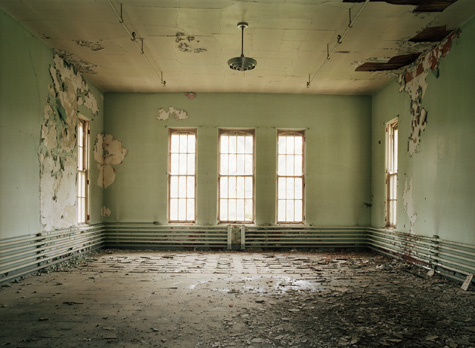 [Image: From Library of Dust by David Maisel, published by Chronicle Books].
[Image: From Library of Dust by David Maisel, published by Chronicle Books].
Yet perhaps there is something altogether more triumphant at work here, something glorious, even blessed. There is a profoundly emotional aspect of these objects, a physical statement that we, too, will alter, meld with the dust and metal: an efflorescence. This, then, is our family narrative, not one of loss but of reunion.
There is a broader kinship being proclaimed, a more important reclamation occurring: the depths of matter will accept us back. We will be rewelcomed out of living isolation. We are part of these elements, made of the dust that forms structures in space.
Maisel’s photographs therefore capture scenes of fundamental reassurance. The mineralized future of everything now living is our end. Even entombed by metal, foaming in the darkness with uncontrolled growths – there is splendor.
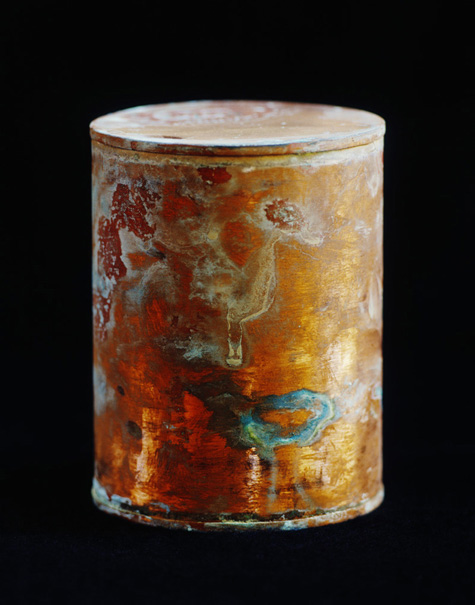 [Image: From Library of Dust by David Maisel, published by Chronicle Books].
[Image: From Library of Dust by David Maisel, published by Chronicle Books].
To disappear into this metallurgical abyss of reactions – photographic, molecular – isn’t a tragedy, or even cause for alarm. There should be no mourning. Indeed, Maisel’s work reveals an abstract gallery of the worlds we can become. Planetary, framed against the black void of Maisel’s temporary studio, the remnant energies of the long dead have become color, miracles of alteration. There are no graves, the photographs proclaim: only sites of transformation.
That is our final, inhuman release.
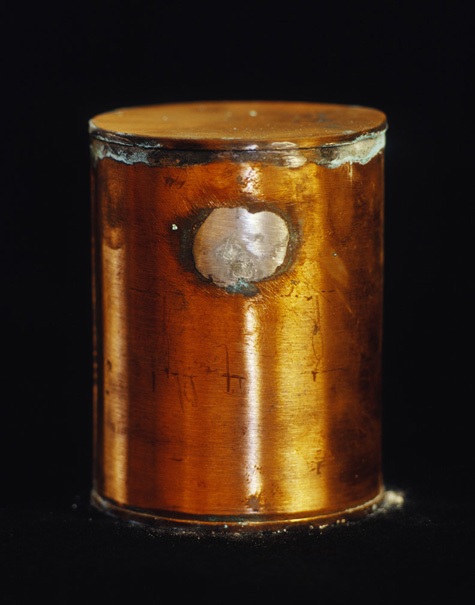 [Image: From Library of Dust by David Maisel, published by Chronicle Books].
[Image: From Library of Dust by David Maisel, published by Chronicle Books].
At the end of winter 2005, David Maisel traveled to a small city in Oregon. There were bridges, plazas, and gates. He was there to locate an old psychiatric hospital – a building now housing violent criminals – because the hospital held something that interested him.
Upon arrival, he met with the head of security, who already knew why Maisel had come. The two of them walked down a nearby corridor, where Maisel was shown what he’d been looking for. It was an isolated room behind a locked door – smaller, less official, than expected.
Within it was the Library of Dust.
• • •
David Maisel’s Library of Dust is available both through Chronicle Books and through Amazon.com – though you can also buy a signed copy through photo-eye.
Don’t miss my earlier interview with David over at Archinect – and, at some point soon, take a long trip through David’s website.
(Thanks to Joseph Antonetti for his help with the images – and to editor Alan Rapp for instigating this book in the first place).
Wow Geoff. Fantastic essay. I’ve been looking forward to this book for over a year and I was pleasantly surprised when I was told that BLDGBLOG would be providing the introduction. This project is just incredible and since I first heard about it, it’s never far been from my thoughts. It is astounding to think that a metal canister can essentially reflect the uniqueness of an individual, visually responding to the chemical remains of their identity — who they are and how they’ve lived. Although I have to admit that my reaction is not as optimistic as yours. I find the entire series profoundly depressing. Insanely compelling, yes, but depresssing nonetheless.
At first I found the images interesting.
Once I learned what they held inside, I became quite emotional.
Incredible beauty in this story.
dust must be in the air. boingboing highlights artist maria a. lopez’s “dust houses” project, in your old stomping ground.
“Dust as a witness of the living. Only memory.”
From Bataille: “Storytellers have not imagined that Sleeping Beauty would have awoken covered by a thick layer of dust; neither have they thought of the sinister spiders’ webs torn by her red hair as soon as she stirred. Yet sad blankets of dust endlessly invade earthly dwellings and soil them uniformly: as if attics and old rooms were being arranged for the imminent entrance of obsessions, of ghosts, of larvae fed and inebriated by the worm-eaten smell of old dust. When the big servant girls arm themselves, each morning, with big feather dusters, or even with vacuum cleaners, they are perhaps not entirely unaware that they are contributing as much as the most positive scientists to keeping off the evil ghosts who are sickened by cleanliness and logic. One day or another, it is true, dust, if it persists, will probably begin to gain ground over the servants, overrunning with vast quantities of rubble abandoned buildings, deserted docks: and in this distant epoch there will be nothing more to save us from nocturnal terrors.”
Quoted in Fantasy, the Uncanny and Surrealist Theories of Architecture Anthony Vidler, 2003
See the essay for more on dust and architecture, also check out Teresa Stoppani who writes about dust.
without doubt the most moving bldgblog essay yet. very beautiful.
Brilliant to see dust on both BLDGBLOG and BoingBoing – I’m writing my Master’s thesis on the dust and need all the encouragement I can get that I’ve picked a decent topic! It’s been tricky as dust is such an elusive thing to research – so rarely mentioned in books on architectural theory or domestic living, and even less frequently helpfully indexed. It’s just too ubiquitous, too mundane, too fuzzy to bother thinking of – but then this enormous absence of something omnipresent is in itself rather interesting.
And if anyone’s reading Maisel’s photography as art before it’s architecture, Jake Kennedy’s essay on dust in the work of Duchamp and Gertrude Stein might be interesting. My dusty lit review is pretty comprehensive by now and this is one of the best articles I’ve found:
http://docs.lib.purdue.edu/clcweb/vol7/iss2/4/
Pure poetry through images… this book will claim a special spot in my library.
thanks.
To Jay:
Check out Ben Campkin’s edited issue on Architecture and Dirt. http://www.informaworld.com/smpp/title~db=all~content=g782445677
It has all kinds of great stuff on dust and architecture.
I wonder what Duchamp and Man Ray, famous for their own work with dust, would have made of these.
Ashes to ashes, dust to dust…
Matthew Rose
This is an incredibly moving, poignant and significant project and post.
However, please don’t take away that the souls were unwanted and unloved as a caveat. They were part of a community – not the “norm” as we conceptualize communities, but community, none the less.
They experienced the same gamut of emotions and attachments as anyone. They laughed, they loved, they mourned, they raged and they FELT. They were alive and were inherently worthy.
Just as those who voluntarily cloister themselves have worth, dignity, meaning and significance, so too did these people who lived and died within the confines of the hospital.
The project and post allows us to be fleeting voyeurs and casual visitors, but our perspective would surely be different had we been fellow residents and care providers and were relating experiences from the perspective of the inside out.
A venn of Maisel and Murakami…what a commingling.
I heard Maisel speak at an artist-in-residency program up in the headlands, north of San Francisco. The images he presented were breathtaking..
We were in a building tucked in the hills, surrounded by old bunkers (remnants of a military presence decades early) and rolling hills… a beautiful, empty, quiet place. Norwegian Wood come alive.
“That is our final, inhuman release. ”
Is it? Or, is it a:
“Systems of information display so avant-garde as to be literally undetectable…a form of public signage that no one can read.”- The “Endless Accident Events” of Los Angeles .
Thanks for posting this article, very cool, photography is amazing as well. I love is this site.
This is beyond fantastic – I'm in love with these photographs. In some ways, it makes me look at death a little differently, too. It's like a last cry of an expression from someone who has been, well, canned in for too long. Chemistry and the natural world collaborating to make these – It's positively gorgeous.
Now the scientist in me must ask: aside from the obvious oxidized copper, was there anything else identified?
The fact of these canisters being carefully and individually photographed is a testament to something inherently beautiful in them; the fact that many people will look at these as I am doing and marvel at the lovliness of them and perhaps get a little glimpse of the holiness of them speaks without words about the human life connected to each of these remains. By now they will have been permanently laid to rest as they should be, but the images are here for all who are willing to look and see, and barely comprehend how unique a picture of human life, and death, this is.
Words are inadequate.
The building that housed these souls, while living and still after death, is itself coming down. Every day I watch as heavy equipment devours this bit of history. The grandest of the trio which made up the Oregon Psychiatric Hospital has been retained, restored. The rest… dust. Appropriate, some would say. Lobotomies, electric shock, locked doors which lead to nowhere and underground passages lit by circles of lavender glass in the sidewalk; the end of what was the end for so many. Yet in the cemetary on the hill, across a street which is no longer called Asylum Avenue, one can still find row after row of tiny, moss-covered headstones. Each is identical the others, each engraved with one word only – BABY. Row after row of tiny souls who never breathed in life outside of asylum, or prison.